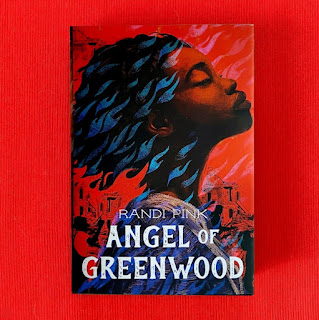
Tomorrow is the 104th anniversary of the Tulsa Race Massacre — the single worst incident of racial violence in United States history. If you have no idea what I’m talking about (and even if you do) you might want to read this book.
Summary: Seventeen-year-old Isaiah Wilson is, on the surface, a town troublemaker, but he hides the fact that he is an avid reader and poet who never leaves home without his journal. A passionate follower of W.E.B. Du Bois, he believes that Black people should rise up to claim their place as equals.
Sixteen-year-old Angel Hill is a loner, mostly disregarded by her peers as a goody-goody but beloved by adults in her community for her sweet and generous heart. Though they’ve attended the same schools, Isaiah never noticed Angel as anything but a quiet, Bible-toting church girl. Then he sees her perform a dance at a church service and finally connects with her brave, free-spirited beauty. When their English teacher offers them a job on her mobile library, a three-wheel, two-seater bike, Isaiah is eager to be in such close quarters with Angel every afternoon.
But life changes on May 31 1921, when a vicious white mob storms the community of Greenwood. Only then do Isaiah, Angel, and their peers realize who their real enemies are. Set in the “Black Wall Street” of Tulsa, Oklahoma, Randi Pink’s novel brings to life a story of tragedy and triumph.
(Summary from book flap – Image is mine)
My Review: The Tulsa Race Massacre began on May 31st, 1921, when the Greenwood district, a vibrant, self-sufficient African American community in Tulsa, Oklahoma, was attacked by white mob, intent on death and destruction. Eighteen hours later, over 1000 Black homes and businesses had been destroyed, 100-300 Black people were dead, and over 800 people were injured. To date, this unthinkable act of racism and cowardice was the single worse incident of racial violence in American history.
Angel of Greenwood is a young adult historical fiction novel set in the days leading up to and including the devastating Tulsa Race massacre. It tells the story of Angel Hill and Isaiah Wilson, two Black teenagers taking their first tentative steps towards young love and independence in the midst of familial struggles, friendship drama, and increased racial tension aimed at their tight-knit community. Angel is unlike anyone or anything Isaiah has every seen — brilliant, bold, fierce, and fearless, but Angel is less-than-impressed with Isaiah, until their shared English teacher invites them to help with her mobile library. As the two are forced to work side-by-side, they find strength in each other, and a shoulder to lean on through the hard times, leading up to the night when their beloved Greenwood district comes under attack.
Angel of Greenwood is an exceptionally well-written love story, emotionally complex, atmospheric, historically valuable, and told in a way that will leave a long-lasting impression on the reader. With compelling characters and meaningful themes about inequality, racism, sexism, and more, there’s a great deal of meat for discussion and plenty of material from which to draw relevant modern day parallels.
The author’s decision to add a daily ‘countdown’ to each chapter heading heightened my anxiety, which certainly kept me reading. I had to know how Angel and Isaiah’s story would end, especially because I knew (at least some of) what was coming. If you’re looking for a book to read that elevates the Black historical narrative, I highly recommend this book — because these stories matter, and neither I nor anyone else should have to Google them because we didn’t learn about them in school.
Note: My only ‘want’ for this book is the same ‘want’ I have for all historical fiction books — a basic separation of the fact from the fiction, when the author chose to adhere to the historical record and when they chose to take a more creative road. I know this isn’t a realistic wish, which is why it’s not a part of my actual review…but I want what I want.
Rating: 5 Stars
For the Sensitive Reader:
Language: I don’t remember any profanity, though it’s possible I missed one or two mild instances.
Sexual Content: Some discussion of a character’s tendency to make out with different girls. Some kissing, making out (no real detail). At one point a character is naked, though the circumstances are not (even remotely) sexual in nature.
Violence: Punching, intimidation, mob violence, looting, and overall destruction of property, threats, intimidating, physical violence (both individual and mob)
Other: Racism, historical trauma, injustice, death of a loved one